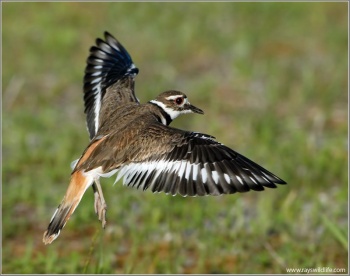(Photo date. Reference updated) |
(Video link) |
||
| Line 23: | Line 23: | ||
==External Links== | ==External Links== | ||
{{GSearch|Charadrius+vociferus}} | {{GSearch|Charadrius+vociferus}} | ||
| + | <br /> | ||
| + | {{Video|Killdeer}} | ||
| − | [[Category:Birds]][[Category:Charadrius]] | + | [[Category:Birds]][[Category:Charadrius]] [[Category:Videos]] |
Revision as of 21:34, 5 October 2012
- Charadrius vociferus
Identification
The only North American plover with a double black breast band.
Distribution
Breeds throughout much of North America as far north as south Alaska and central Canada and winters in Atlantic and Pacific states and in the southernn USA southwards. In the east breeds north to Quebec and Newfoundland and occasionally taken north to Newfoundland in late autumn and winter by storms on the Atlantic coast. This is the origin of transatlantic stragglers.
Vagrants recorded in Iceland, Faroes and British Isles, south to Spain, Portugal and the Azores and east to Hungary and Romania. Most records come from the British Isles (c.47 British records) in late autumn, winter and early spring and although well-scattered the majority are in the south-west and especially on Scilly.
Taxonomy
Subspecies
There are 3 subspecies1:
- C. v. vociferus - Canada, US and Mexico; winters to north-western South America
- C. v. ternominatus - Greater Antilles
- C. v. peruvianus - Peru and north-western Chile
Habitat
Open grassy land including pastures, lawns, airfields and golf courses. Also mudflats, along shorelines and beside gravel-pits, especially in winter.
Behaviour
Notorious for its "broken-wing" display to distract predators from nests and young.
References
- Clements, JF. 2011. The Clements Checklist of Birds of the World. 6th ed., with updates to August 2011. Ithaca: Cornell Univ. Press. ISBN 978-0801445019. Spreadsheet available at http://www.birds.cornell.edu/clementschecklist/downloadable-clements-checklist
Recommended Citation
- BirdForum Opus contributors. (2024) Killdeer. In: BirdForum, the forum for wild birds and birding. Retrieved 3 May 2024 from https://www.birdforum.net/opus/Killdeer
External Links





